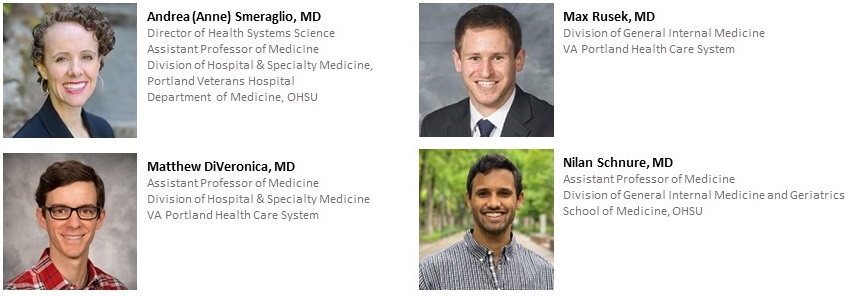Curriculum

The OHSU Internal Medicine curriculum provides training leading to qualification for entry to the certifying exam of the American Board of Internal Medicine (ABIM). Graduates of our programs have achieved a 97% first attempt pass rate over the last three years. See ABIM site for data on the board pass rates for all internal medicine programs.
The major focus of our residency program is train future physicians to be outstanding clinicians, responsible learners and mindful practitioners in a strong training environment which also supports outstanding scholarship opportunities. As the only University-based training program in the state of Oregon, we have a broad mission in serving the public interest. This mission ranges from training physicians in primary care to hospital medicine to specialty and investigative careers.
Our residents divide their time among general medicine and subspecialty wards, intensive care units, ambulatory care, consultation services; and long-term care settings. Those residents planning careers in primary care can complete in their PGY-2 year, a community-based preceptorship, usually in a rural area of Oregon and in their PGY3 can spend additional time in ambulatory care, focusing on behavioral medicine and experiences in related areas such as gynecology, dermatology and medical orthopedics or other needed areas.
Our PGY-1 residents spend their first year at OHSU Hospital and the adjacent VAMC (“the hill”), which are connected by a sky-bridge. We believe in keeping the first year rotations on the "hill" in order to foster strong collegial relationships between the first years and the other housestaff and faculty. In addition to acquiring experience in general inpatient and subspecialty medicine, interns rotate through ambulatory care and emergency room services, intensive care units, geriatrics, neurology and subspecialty consultation services.
The PGY2 and PGY3 years will have a mix of general and intensive care units, where residents supervise a team of interns and students, and subspecialty consultation services ("selectives"), electives and ambulatory blocks. Residents rotate for two months in both their PGY2 and PGY3 years at Kaiser Permanente in Portland and may rotate for one month at another local hospital (Providence Portland). Our residents also rotate at a community based hospital on the Oregon Coast (Coos Bay) where they see patients who have a diverse array of medical conditions and often ones that are not necessarily seen at a tertiary center. These community-based facilities provide exposure to a broad-based and diverse practice environment, as well as diverse medical conditions.
Finally, as part of our scheduling system (X+Y), all residents spend one week in clinic each month. This curricular approach to ambulatory medicine allows residents exposure in ambulatory medicine, from primary care clinics to primary care based clinics (musculoskeletal, gynecology, dermatology, etc.) and subspecialty clinics (renal, cardiology, pulmonary, HO, etc.). Our curriculum in this +1 week has also been restructured to provide a cohesive set of learning objectives/teachings each month.

Overview
At OHSU we are cultivating the next generation of Health Systems Science leaders through interactive curricular training, project-based learning and scholarship. We offer residents dedicated educational time and committed faculty mentors to develop skills, participate in and lead change through a myriad of inpatient and outpatient opportunities.
Health Systems Science Education:
Teaching Improvement Science (TIS) Curriculum
The TIS curriculum offers innovative teaching of Health Systems Science curricula to trainees. Developed at OHSU, this curriculum is now sponsored by the American Medical Association and shared nationally as a model of comprehensive and innovative Health Systems Science training. Delivered for a during the +1 week for one-half day per month during intern year, TIS teaches the full spectrum of health systems thinking with the understanding that making our systems better can promote well-being. Our interns develop a greater appreciation of how health systems not only impact our patients but also us as providers-ultimately working towards happy, productive physicians who are agents of change, creating a safer and more equitable healthcare system.
TIS Curriculum:
- House of Horrors-Errors in Medicine
- Quality Improvement: A simulated QI project
- Diagnostic Errors: Understanding how we think
- Value Based Care: Providing affordable quality care
- Teamwork: Simulation Center teamwork activity
- Mystery Dinner Root Cause Analysis: A gamified and simulated RCA
- Error Disclosure & Second Victim: A peer lead workshop
- Narrative Medicine: Processing errors
- QI-EBM: Quality Improvement Evidence Based Medicine
Health Systems Projects
Residents help improve our hospital through Health System Projects as part of the TIS curriculum. The projects are done in small groups of 2-4 interns and are selected based off intern interest. These projects can span the range of Health Systems Science domains and take place in any division (primary care, hospital medicine or specialty care) to align with resident career development. Projects are created during intern year but faculty support is provided into R2/3 year for those who wish to carry projects forward for scholarly purposes.
Sampling of Health System Projects from 2024/2025:
- Penacillin de-labeling on inpatient wards
- Use of contraception for teratogenic medications in rheumatology clinic
- Improving education for outpatient antibiotic therapy
- Developing personalized pain plans for sickle cell patients
- Limiting police involvement on inpatient services
- Developing diuretic algorithms for heart failure admissions
- Delays in inpatient transfusions
Additional Health Systems Science Opportunities:
Scholarship in Health Systems Science
There are numerous scholarly opportunities available in Health Systems Science at OHSU. All residents complete a Health Systems Science project with faculty mentorship designed to support scholarly output. There are also opportunities through PBL&I to participate in clinic-based projects as well as numerous ongoing inpatient and outpatient projects. A list of available health system projects is kept updated to facilitate resident involvement. Our residents have published articles, posters, abstracts and won local/regional ACP/SGIM awards for their involvement in Health Systems Science projects.
OHSU Housestaff Quality & Safety Counsel
The OHSU HQSC is a multi-specialty group of house officers that meets monthly to discuss hospital-wide quality and safety initiatives, review house officer-submitted safety event reports, and provide peer coaching for individual quality and safety initiatives. The HQSC is a part of OHSU’s formal quality oversight infrastructure, so participation provides house officers with a high visibility opportunity for engagement and leadership development in health system improvement. Previous HQSC projects have also given residents the opportunity to contribute to conference presentations and publications. To get involved, email the group’s administrative coordinator, Sam Milholland
VA Chief Resident in Quality & Safety
The CRQS program at VA Portland and OHSU is a one-year post-residency training for Internal Medicine graduates. Throughout their chief year, the CRQS focuses on learning and teaching about quality and patient safety while also engaging in improvement activities at VA Portland. The CRQS is available as a consultant and a mentor for quality and safety related issues for residents interested in improvement.
Practice Base Learning & Improvement (PBL&I)
This clinic-based curriculum is designed to help residents develop mastery in the management of a portfolio of important chronic illnesses in primary care. Faculty facilitators provide up-to-date guideline recommendations and review relevant clinic resources. Residents then use illness-specific registry reports, identifying patients with the targeted illnesses and an array of relevant data to highlight care gaps. They engage in proactive planning, setting of chart reminders, and outreach to patients, with a goal to close gaps in care. This curriculum encourages residents to take pride in their work as primary care providers, reinforces learning through direct patient care, and enables residents to be conscientious stewards in their patients’ care. It reviews many of the QI/PS skills learned in the TIS curriculum and encourages involvement in clinic-wide and individual improvement projects.
VA Resident Huddle
Experience a Health Systems Huddle first-hand through the Portland VA Internal Medicine Resident Huddle. This weekly inpatient huddle reviews systems changes and quality and safety performance feedback to keep residents informed and part of ongoing systems improvement.
Learn More:
Interested in learning more about what OHSU teaches as part of our innovative Teaching Improvement Science Curriculum? Visit our website sponsored by the American Medical Association at TeachIS.org to experience the curriculum first-hand. Or contact our Director for Health Systems Science Dr. Andrea (Anne) Smeraglio
Advocacy Curriculum Co-Directors

A Culture of Advocacy
We believe that in order to truly promote health in our communities, we need to address the root causes of illness. Many of our residents are drawn to medicine because of their commitments to human welfare and social justice. There is no doubt that they honor those commitments through excellence at the bedside. At the same time, bedside medicine has limitations. The consequences of social determinants like systemic racism, housing insecurity, hunger, and poor access to healthcare are all around us. Advocacy can offer solutions to these ills where clinical medicine falls short. Our residents have organized community fund-raisers, written letters to the editor, reached the public through local news interviews, and participated in legislative advocacy at the state and national level.
While our culture of advocacy is baked into all that we do, our health advocacy curriculum empowers each of our residents find their voice as healers and leaders for the health of communities. We firmly believe that empowering and supporting residents in physician advocacy helps foster fulfillment and a sense of purpose in medicine.
PGY-1 Advocacy Curriculum
All PGY-1 physicians are exposed to the core advocacy principles through a formal advocacy curriculum. There are several major components of the curriculum:
- Advocacy Workshops: during the ambulatory +1 week, interns participate in advocacy workshops. Each workshop is designed to provide knowledge of the topics, and develop skills for effective physician advocacy. Workshops include “Interacting with Legislators,” “Engaging with Media,” and other foundational topics.
- Community Advocacy Project Tool: each intern spends time during their Social Medicine rotation on a topic that they are passionate about. Using a specific tool, and with weekly mentoring sessions, residents develop a framework for creating change in an area of their own personal interest. While the expectation is that interns develop and complete the project on paper as a thought exercise, some carry out their projects in the real world, making a true impact on the community. Others have used the tool as a jumping off point for advocacy scholarship. For example, Dr. Emma Deloughery met with her state legislator to put her advocacy plan in motion (see below).
PGY-1/2/3 – Elective Advocacy Opportunities
For all residency classes, elective opportunities for advocacy and advocacy training are available. Examples include the use of elective time for advocacy projects; local and regional public health advocacy in partnership with the Oregon Chapter of the American College of Physicians; and national advocacy in partnership with internal medicine professional societies such as the American College of Physicians or the Society for General Internal Medicine.
Each year, our program supports interested residents in attending Oregon ACP Advocacy Day, a day at the Oregon state capital where residents learn from advocacy experts and engage with their own legislators about legislation that impacts our patients and our profession.
Our Residents’ Impact
In recent years our residents’ advocacy has helped to pass legislation at the state and national level promoting public health in areas of health care access reform, firearm injury prevention, climate change harm mitigation, tobacco regulation, and prescription drug pricing as well as adoption of public health measures during the COVID-19 pandemic and increasing access to addiction treatment services. Resident advocacy has also promoted physician mental health, including advocating for revisions to the Oregon Medical Board’s medical license application that eliminated stigmatizing language about mental illness on the state license application. They’ve promoted COVID vaccines in local newspapers and local TV news for the sake of public health. And they’ve published advocacy pieces on climate change and its impact on vulnerable populations.
Noon Report
Noon report is held Mondays and Fridays at OHSU and lasts 1 hour. At each session, a resident presents a clinical case and a chief resident facilitates a discussion focusing on diagnosis and/or management, with an emphasis on clinical reasoning, problem solving, and evidence-based medicine. Generalist and subspecialty faculty regularly attend and participate.
On Fridays, we also have a distinct and separate Intern Report which has a curriculum that follows the progressive development of an intern. This curriculum focuses on everything from physical exam development to diagnostic reasoning and special case conferences to highlight key core concepts one should know in the intern year.
Noon Conferences
Noon conferences are the forum for our core internal medicine curriculum which is presented over 18 months and is thus presented twice during a resident's tenure in the program. Noon conferences are presented on Tuesday, Wednesday, and Thursday. During the initial 2 months of each academic year, the noon conference is devoted to a review of medical emergencies and urgencies that interns and residents will encounter in the ICU and wards in particular.
In addition to the core curriculum, the noon conference series includes additional content such as a monthly interactive EKG conference, clinical problem solving challenges, Fireside chats with the Program Director, fellowship advice and much more.
Check out our conference schedule on IMRESPDX.